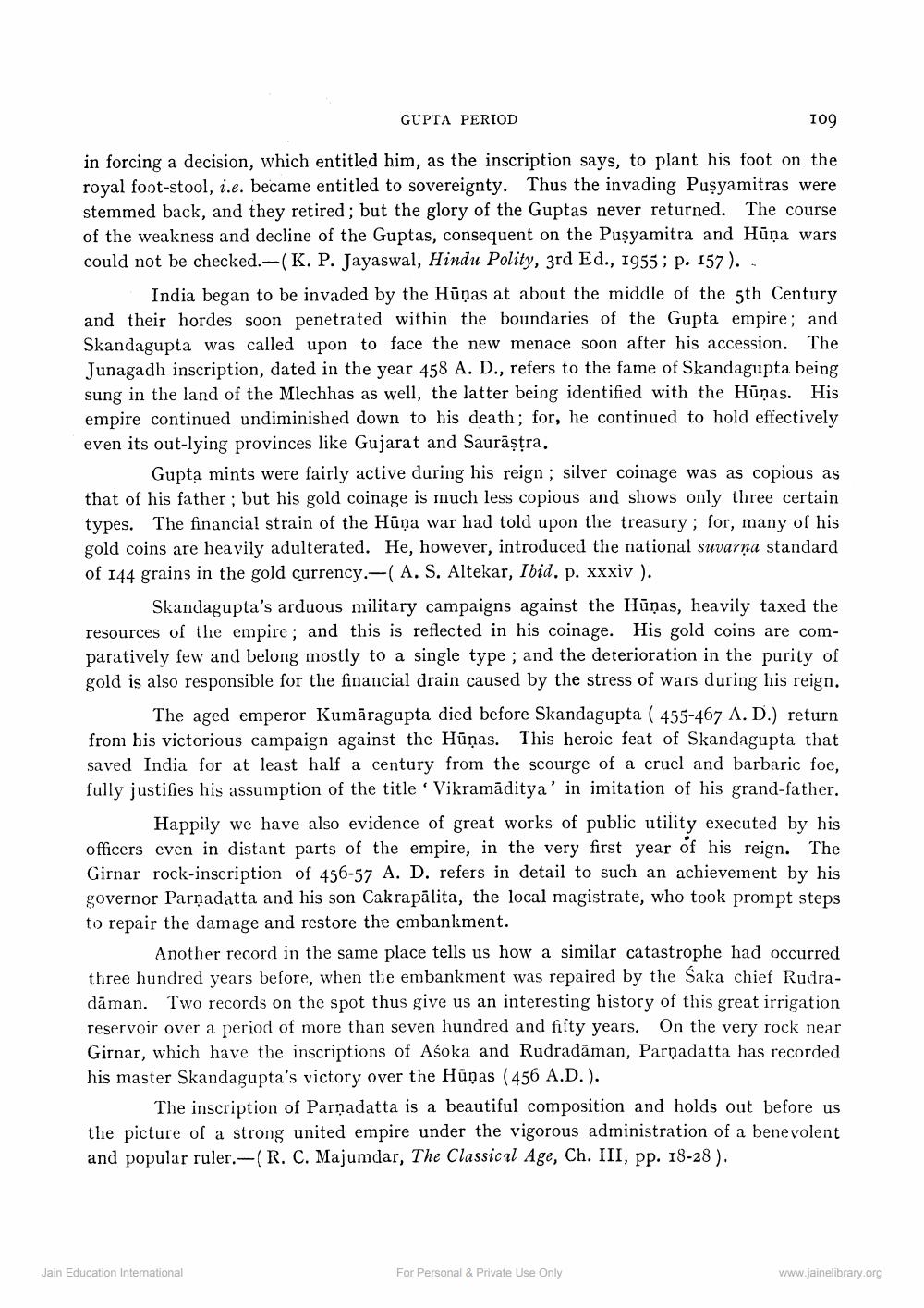________________
109
in forcing a decision, which entitled him, as the inscription says, to plant his foot on the royal foot-stool, i.e. became entitled to sovereignty. Thus the invading Pusyamitras were stemmed back, and they retired; but the glory of the Guptas never returned. The course of the weakness and decline of the Guptas, consequent on the Puşyamitra and Hūna wars could not be checked.-(K. P. Jayaswal, Hindu Polity, 3rd Ed., 1955; p. 157). .
GUPTA PERIOD
India began to be invaded by the Hupas at about the middle of the 5th Century and their hordes soon penetrated within the boundaries of the Gupta empire; and Skandagupta was called upon to face the new menace soon after his accession. The Junagadh inscription, dated in the year 458 A. D., refers to the fame of Skandagupta being sung in the land of the Mlechhas as well, the latter being identified with the Hūņas. His empire continued undiminished down to his death; for, he continued to hold effectively even its out-lying provinces like Gujarat and Saurāṣṭra.
Gupta mints were fairly active during his reign; silver coinage was as copious as that of his father; but his gold coinage is much less copious and shows only three certain. types. The financial strain of the Hūņa war had told upon the treasury; for, many of his gold coins are heavily adulterated. He, however, introduced the national suvarya standard of 144 grains in the gold currency.-( A. S. Altekar, Ibid. p. xxxiv).
Skandagupta's arduous military campaigns against the Hūpas, heavily taxed the resources of the empire; and this is reflected in his coinage. His gold coins are comparatively few and belong mostly to a single type; and the deterioration in the purity of gold is also responsible for the financial drain caused by the stress of wars during his reign.
The aged emperor Kumaragupta died before Skandagupta ( 455-467 A. D.) return. from his victorious campaign against the Hūņas. This heroic feat of Skandagupta that saved India for at least half a century from the scourge of a cruel and barbaric foe, fully justifies his assumption of the title Vikramaditya' in imitation of his grand-father,
Happily we have also evidence of great works of public utility executed by his officers even in distant parts of the empire, in the very first year of his reign. The Girnar rock-inscription of 456-57 A. D. refers in detail to such an achievement by his governor Parnadatta and his son Cakrapalita, the local magistrate, who took prompt steps to repair the damage and restore the embankment.
Another record in the same place tells us how a similar catastrophe had occurred three hundred years before, when the embankment was repaired by the Saka chief Rudradaman. Two records on the spot thus give us an interesting history of this great irrigation reservoir over a period of more than seven hundred and fifty years. On the very rock near Girnar, which have the inscriptions of Asoka and Rudradāman, Parpadatta has recorded his master Skandagupta's victory over the Hupas (456 A.D.).
The inscription of Parpadatta is a beautiful composition and holds out before us. the picture of a strong united empire under the vigorous administration of a benevolent and popular ruler.-(R. C. Majumdar, The Classical Age, Ch. III, pp. 18-28).
Jain Education International
For Personal & Private Use Only
www.jainelibrary.org




